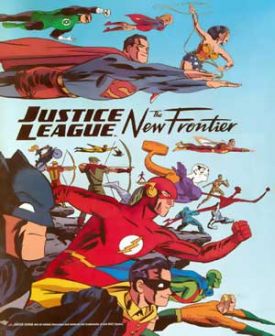|
|
 |
Justice League: The New Frontier is directly inspired by the DC Comics’ series created by Darwyn Cooke and published in 2003 and 2004. The comic book series was a direct sequel of sort to another series, called The Golden Age, about the first generation of super heroes. The adaptation to animation is part of Warner Premiere’s film to video series based on DC Comics’ properties.
Here we follow the lives of test pilot Hal Jordan, police officer, Barry Allen, Superman, The Martian Manhunter, Batman and Wonder Woman as they try to stop the Center from taking over the planet. We follow each of their lives in a myriad of plots that eventually all assemble for the big finale against the enemy. Like all recent Justice League animated contents, the handling of the characters and themes is very mature and suitable for an adult audience.
Having not read the original comic book series, I cannot compare or glance at where the plot has been simplified to fit a large story into a 75 minutes feature. However, one does get the sense that much has been left out. For example, there a lot of back story about the Justice Society that is ignored, while the appearances of heroes like Green Arrow and Aquaman, suggest that they had more screen play in the comic book.
Yet, there are great moments to Justice League: The New Frontier. For example, it is the first time that I have felt a genuine difference between reporters Lois Lane and Iris West. Both have the same job, yet both are different women. In the comic book world, it took decades before Iris West ever moved away from the super hero girlfriend template created by Lois Lane. The same is true about Carol Ferris, would-be girl friend of Hal Jordan. Here, she is a strong woman whom conveys that she has what it takes to occupy the job she has.
While playing with the old Silver Age classics, this film also cuts the heroes away from the interchangeable mould that they were plagued with in old comic books. It is impossible to exchange Barry Allen for Hal Jordan. This is refreshing for once.
The pace of the story worked and the finale was quickly introduced. This is where I felt that the story was weaker as all the built up only ended up being another big fight with the right amount of sacrifice from the main players. All of that and the eventual coming of age of Hal Jordan were quite predictable.
The artwork captured Cooke’s art, but was a bit too similar to the regular Justice League series from Cartoon Network. There was almost differentiation in the styles, which will surely confuse some viewers who will expect this film to be related to the other series. As for the 1950s designs, it all looked kind of right, but although the shapes and forms were respected, it did not feel like the backgrounds and props were from that era. Instead, it looked like modern backdrops with faux-1950s stylings. A movie that achieved a real 1950s look without having been set in the 1950s, was the Wings of the Honneamise. In that film, the design of 1950s elements went beyond shapes and styles. It also had 1950s utilitarian qualities. Objects were designed and placed on screen and had proportions to one another and the characters that really evoked the 1950s. In Justice League: The New Frontier, there was no overall sense of 1950s utilitarian designs. The relationships of objects and backdrops did not relate well with the characters. More work on the design qualities of the film would have avoided the feeling of fake 1950s stylings.
The DVD extras of the regular version are interesting and offer a biased and limited history of DC Comics. As for the commentaries, they don’t add much to the understanding of the film. The deluxe version of the DVD includes three episodes of the old Justice League series, which will help confuse newer viewers even more. As for die-hard collectors, they probably have them already and won’t find their addition to this collection a bonus.
© Copyright 2002-2019 by Toon Doctor Inc. - All rights Reserved. All other texts, images, characters and trademarks are copyright their respective owners. Use of material in this document (including reproduction, modification, distribution, electronic transmission or republication) without prior written permission is strictly prohibited.

